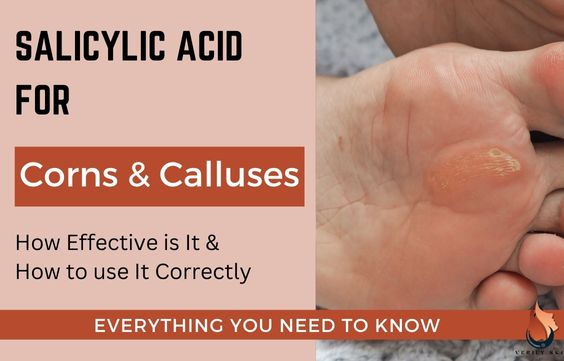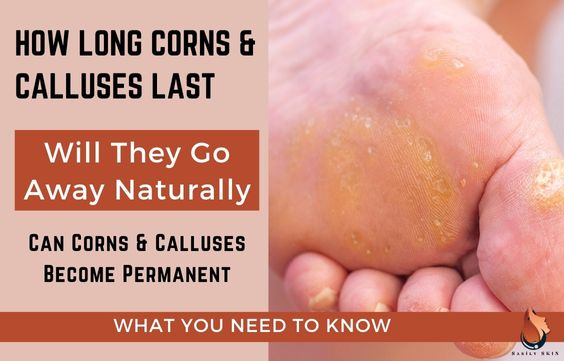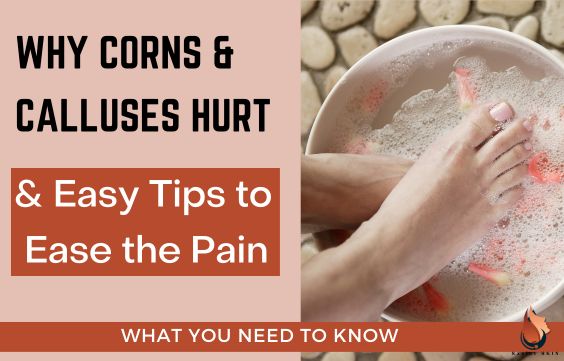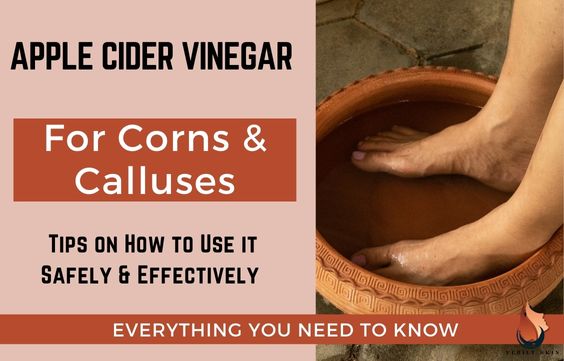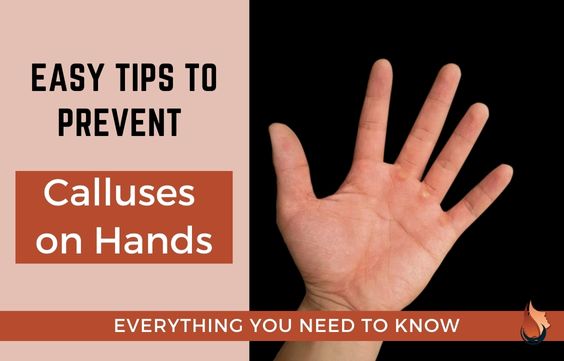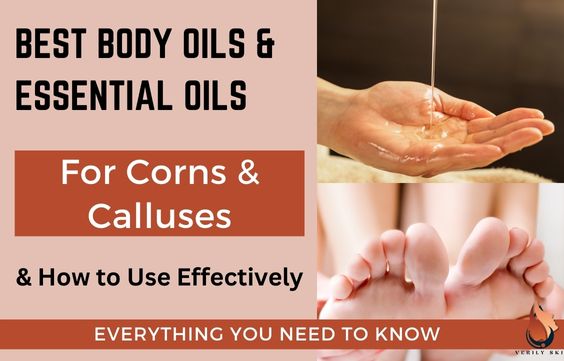Quick Remedies & Medical Treatments for Corns & Calluses
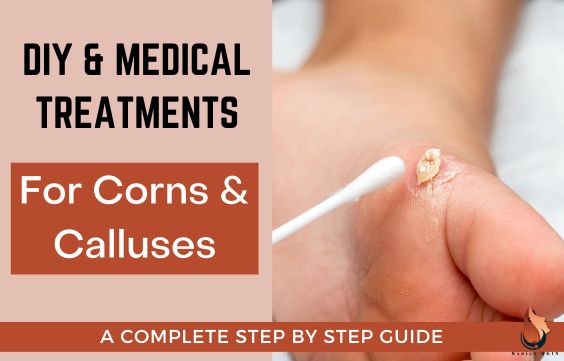
Corns & Calluses can be painful and stubborn to treat. However, there are a variety of things that you can do to manage them and prevent them from getting worse and reoccurring.
There are simple lifestyle changes that you can make, easy home remedies, and professional treatment options that you can consider depending on how bad your corns or calluses are. In this article, I’ll discuss our options.
First Things First: Are Corns & Calluses Treated The Same Way
The general concept around treating corns & calluses is the same: to remove the buildup of skin. However, certain parts of the management process can differ based on the type of corn or callus and its severity.
Additionally, corns and calluses on your hands and the ones on your feet are treated in almost the same way as well. The ones on your hands may or may not be easier to treat and take less time for you to see a difference. But again, the concept is the same.
Related Articles:
Corns vs Calluses – What are the Differences & Types
Why Do Corns & Calluses Hurt & Easy Tips to Ease the Pain
How Do You Treat Corns & Calluses
Treatment and management aim to:
- Soften the skin,
- Get rid of any thickened skin patches,
- And prevent them from coming back.
The first line of treatment for typical corns & calluses is usually home management.
Related Articles: Infected Corns & Calluses – How To Spot & Trea
How to Treat Corns & Calluses at Home
First Step: Softening Your Corn or Callus
This step is quite easy. Here is what to do:
- Clean your feet
- Prepare a foot bath of warm water. You can also add some Epsom salt (optional).
- Soak your feet in the warm water bath for 5-15 minutes until the skin around the corn or callus becomes soft.
Second Step: Removing the built-up skin
This is where you might need some experience but it is still easy to do at home. Here is what to do:
- Get a clean pumice stone and soak it in the warm water
- Use the stone to gently file away the softened, thickened, dead skin from around the corn or callus.
- Use gentle, circular, or sideways motions to remove the skin.
- Do not remove too much skin. Your feet should not be bleeding or tender when you are finished.
Third Step: Caring for the area
After you remove the thickened skin, your feet will be tender and easily irritated. It will benefit from some TLC and measure to prevent irritation and infections.
In this step, you will moisturize the area well. I recommend using a moisturizer that contains salicylic acid, ammonium lactate, or urea. Applying these ingredients along with other moisturizing ingredients every day will help to keep the skin of the area soft. This will prevent another build-up of thickened, dead skin cells.
Fourth Step: Lifestyle Adjustment
This is the step where you will make changes to your routine to prevent corns and calluses from getting worse or recurring.
Here are a few things that I would recommend doing:
- Use protective padding to protect the area. You can make your own padding or you can purchase simple ones from Amazon that are affordable and work well.
To make your own padding you can use lamb’s wool between your toes to prevent friction, or you can use moleskin (available at pharmacies) cut into half circles to place around the corn or callus.
- Use shoes that are right for your feet
- Use insoles
- Wear socks
- Wear gloves for your hands and adjust your grip when lifting heavy things or using tools that can cause friction. Also, remove rings and other things that could be causing friction or restricted movement between your fingers.
- Take care of existing corns and calluses regularly
Check these articles out to learn more about how to prevent corns & calluses on your hands and feet and for directions on where to obtain great pads, insoles, gloves, and everything you might need to help:
Tips on How to Prevent Calluses on Your Hands
Tips on How to Prevent Calluses & Corns on Your Feet
DIY Remedies For Corns & Calluses
Apart from soaking, filing, and certain lifestyle changes as discussed above, there are also a few remedies that you can try at home that can help your corns & calluses. Here are a few:
1- Essential Oils & Body Oils
Many essential oils and natural body oils have moisturizing, softening, and even exfoliating properties. They also have antimicrobial and healing properties.
These make them great for helping to soften corns and calluses for filing and removal and then help to prevent them from worsening or reoccurring by preventing infection, healing the skin, and keeping the area soft and moisturized.
Some of them can produce a noticeable difference in the texture of the corn and callus overnight!
The best essential oils for corns & calluses are:
- Tea Tree Oil
- Clove Oil
- Oregano Oil
- Garlic Oil
- Lavender Oil
- Peppermint Oil
- Roman Chamomile Oil
- Turpentine Oil
- Lemon Oil
The best body oils for corns and calluses are:
- Coconut Oil
- Olive Oil
- Jojoba Oil
- Sweet Almond Oil
- Argan Oil
- Rosehip Oil
- Black Seed Oil
- Sunflower Oil
- Avocado Oil
Click here to read more about how they work and how to use them: Best Essential Oils & Body Oils to Treat Corns & Calluses
2- Apple Cider Vinegar
The acetic acid in apple cider vinegar will kill bacteria and loosen up dead skin cells, making them much softer and easier to remove with a pumice stone.
Apple cider vinegar is one of the most commonly used home remedies for corns and calluses. You simply mix about ½ – 1 cup of apple cider vinegar with 2 cups of water and soak your feet in the mixture for 20-30 minutes.
Depending on how thickened your corn or callus is, you might be ready to file them down after just one soak or you may need to soak your feet multiple times (once every night or once every day).
Click here to read more about how to use ACV for corns and calluses: Apple Cider Vinegar For Corns & Calluses – What To Know
3- Hydrogen Peroxide
Although doctors advise against using hydrogen peroxide on the face and other sensitive parts of the skin, it may be used safely and efficiently to treat athlete’s foot, nail fungus, and to soften corns and calluses as well as cracked heels.
Hydrogen peroxide damages the collagen and fibroblasts that hold the thickened skin together around corns and calluses. This makes the area softer and the skin much easier to remove when filing.
- The easiest way to use hydrogen peroxide is to mix 2 cups of 3% hydrogen peroxide with 2 cups of warm or room-temperature water
- And soak your feet in the mixture for 20-30 minutes.
Click here to read all the important facts about using Hydrogen Peroxide for Corns & Calluses: How to Safely Use.
Medical Management of Corns & Calluses
Generally, the first line of treatment for corns and calluses is home treatments and DIYs aimed at softening and filing down the thickened skin.
If those do not help enough, doctors and podiatrists turn to manual trimming and removal of the built-up skin. If that does not work, they may then turn to chemical treatments.
1- Manual Removal Of Thickened Skin
This sounds worse than it is.
- Medical professionals will numb the area using local anesthesia so you will not feel a thing.
- Next, they will clean the corn or callus
- And then use a blade or debriding instrument to gradually cut away the dead, thickened skin.
This is done slowly, carefully, and gradually to avoid cutting away too much skin at one time and to prevent bleeding and exposure to possible sites of infection.
Needless to say, this needs to be done by a trained professional in a clinical or office setting. I recommend seeing your doctor first to discuss the procedure so that you know exactly what is being done and how it will help you.
This is usually done for corns and calluses that are severe and that have not been improved by soaking and filing and other home treatments.
If you prefer not to have your corn or callus manually removed, there are also chemical treatments that your doctor can advise you about. The most common one is salicylic acid.
Video- Podiatrist Corn removal with callus: over 1-year-old corn.
2- Salicylic Acid
Salicylic acid can be used to effectively remove corns and calluses. However, this should be prescribed and directed by a dermatologist/podiatrist/doctor.
The concentration of salicylic acid needed to treat corns and calluses is very high (40%) and while patches and even chemical solutions with this concentration can be obtained over the counter, I do not recommend that you use them on your own.
40% salicylic acid can result in chemical burns if used incorrectly. Therefore, I recommend that you at least speak to your doctor about it before using it.
With that being said, we have done tons of research and have put together all the important things you should know when using salicylic acid for corns and calluses. Click here to read all about Salicylic Acid for Calluses & Corns: What You Need to Know.
3- Surgical Treatment
So far, all of the methods and remedies that we have talked about are conservative treatment measures. However, if these fail, and if your corns and calluses are being made worse by anatomical abnormalities (bony prominences and other bone abnormalities), then surgery to correct them is your next option.
A huge and common indicator of a need for surgery is chronic foot pain being caused by the corn or callus despite intensive medical management.
The kind of surgery you will need will depend on what kind of bone abnormality is causing the problem. Therefore, I strongly recommend that you keep up to date with your doctor.
They can track your treatment, and observe how they are working (if at all). They can also diagnose whether you have a bony problem causing the corn and calluses, what kind of problem it is, and whether you will need surgery to fix it.
Your doctor will then most likely consult with an orthopaedic surgeon and together they will guide and advise you on what kind of surgery you will need.
Sources
1-How to treat corns and calluses
2-Corns and calluses: What’s the difference and how can I treat them?
3-Corns and calluses Information | Mount Sinai – New York

